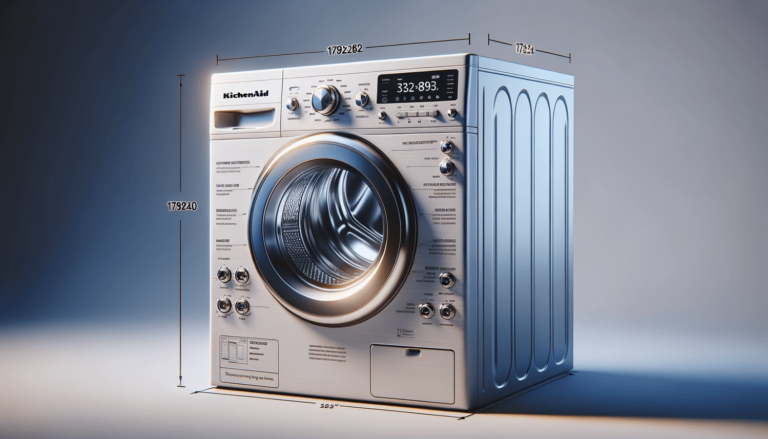

Welcome to our comprehensive guide on KitchenAid Washer Settings Explained. Providing the utmost convenience and versatile options for cleaning your garments, KitchenAid’s washing machines have long been a top choice for households worldwide. In this post, we aim to demystify the various KitchenAid Washer Settings, ensuring you maximize the performance and efficiency of your laundry routines. From the basic settings to the advanced programs, join us as we explore the ins and outs of KitchenAid’s user-friendly washer settings
KitchenAid Washer Settings include several basic settings that are essential for everyday laundry tasks. These settings provide the optimal cleaning for different types of garments.
KitchenAid washing machines offer customizable temperature settings to accommodate various types of fabrics and stains. Selecting the right temperature setting can help prolong the life of your garments while also improving cleaning performance.
Choose from different spin speeds to regulate the washer’s spinning intensity. The higher the spin speed, the more water is extracted from the clothes, reducing drying time. However, delicate fabrics may require lower spin speeds to prevent damage.
The Soil Level setting allows you to adjust the wash and rinse time according to the dirtiness of the clothes. The dirtier the clothing, the longer the cycle is needed to remove all the grime.
KitchenAid washing machines also come with a range of additional settings and features to enhance the washing experience and address specific cleaning needs.
As the Settings King team who is passionate about optimizing technology settings, we are here to provide supplementary information on how to accomplish common functions using KitchenAid washer settings, ensuring impeccable clothes every time.
To protect your delicate fabrics, simply set the washer settings to ‘Delicate’ mode with ‘Low’ spin speed and ‘Cold’ temperature. This combination will gently clean the garments without causing damage or shrinkage.
Pretreating stains often makes a significant difference. Apply a stain remover directly to the stain before placing the item in the washer. Use the ‘Pre-Wash’ setting to give the garments a brief soak, followed by the appropriate cycle and soil level. For effective stain removal, choose ‘,’Hot’ temperature where possible.
To minimize wrinkling, use the ‘Permanent Press’ mode. This cycle combines a warm wash with a slow spin speed, preventing excessive agitation that could cause wrinkles. Remember to promptly remove your laundry from the washer once the cycle is complete.
Energy efficiency is crucial for both your utility bill and the environment. Utilize the ‘Cold’ temperature setting for the majority of loads and reserve ‘,’Hot’ for particularly stubborn stains or loads requiring sanitization. Additionally, employing the ‘Quick Wash’ mode for lightly soiled clothes conserves water and energy.
Proper maintenance of your KitchenAid washer can prolong its life and ensure optimum performance. Being well-versed with washer settings, we at Settings King, a blog about technology settings, have some helpful tips and suggestions for taking care of your investment.
Regular cleaning of the washer drum is essential for preventing buildup and unpleasant odors. To clean your KitchenAid washer drum, initiate a ‘,’Normal’ or ‘,’Heavy load cycle using hot water and add a washing machine cleaner or white vinegar instead of detergent. This will help remove any residue and keep your washer smelling fresh.
Lint filters can become clogged over time, impacting your washer’s performance. We recommend inspecting and cleaning the filter regularly to prevent any potential issues. Consult your owner’s manual for the specific location and instructions for your particular model.
Make sure your washing machine is placed on a level surface. Unbalanced placement can cause excessive vibration and noise, leading to unnecessary wear and tear on the machine. If necessary, adjust the feet to stabilize your washer and avoid any issues.
To maintain both your washer and your clothing, always read the garment labels before washing. Labels provide essential information about the suitable washer settings, ensuring proper care for your garments and preventing damage to your machine or wardrobe.
Additionally, following the manufacturer’s recommendations for detergent usage, load size, and energy efficiency can contribute to the overall longevity of your KitchenAid washing machine. Utilize your washer’s settings to their fullest potential and enjoy consistently clean and fresh laundry every time.
After reading our KitchenAid Washer Settings Explained blog post, you may have further inquiries. Our FAQ section provides answers to some of the most common questions readers ask regarding washer settings and maintenance.
KitchenAid washers perform best with high-efficiency (HE) detergents, which are designed to produce fewer suds and work optimally in low water conditions. Using the recommended amount of detergent as per the manufacturer’s guidelines will ensure effective cleaning without residue buildup.
Cleaning the washer drum once a month or after every 30-40 loads is a good rule of thumb. However, if you frequently wash heavily soiled items or use a lot of detergent, consider cleaning the drum more often to prevent odor and residue buildup.
Excessive vibration can be caused by an unbalanced load, an uneven surface on which the washer is placed, or worn-out leveling feet. Make sure to evenly distribute the laundry, level your washer, and check the feet regularly to prevent unnecessary wear and tear on the machine.
Yes, you can use bleach in your KitchenAid Washer for stain removal on white and bleach-safe garments. Always follow the manufacturer’s instructions for the correct usage of bleach and avoid mixing it with other chemicals to prevent potential damage to your clothes and your washing machine.
KitchenAid washers are equipped with automatic water level sensors that adjust the amount of water used based on the load size. Therefore, it’s not necessary to manually adjust the water level for each load. Simply follow the manufacturer’s instructions for load size guidelines to optimize water usage and cleaning performance.